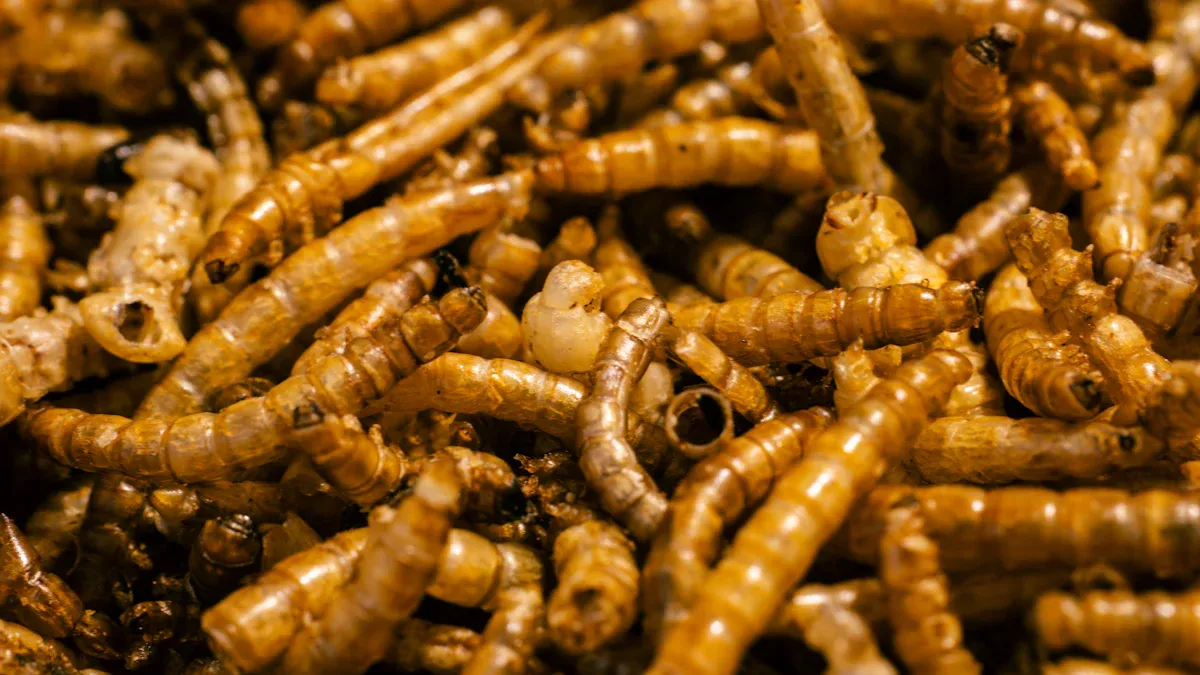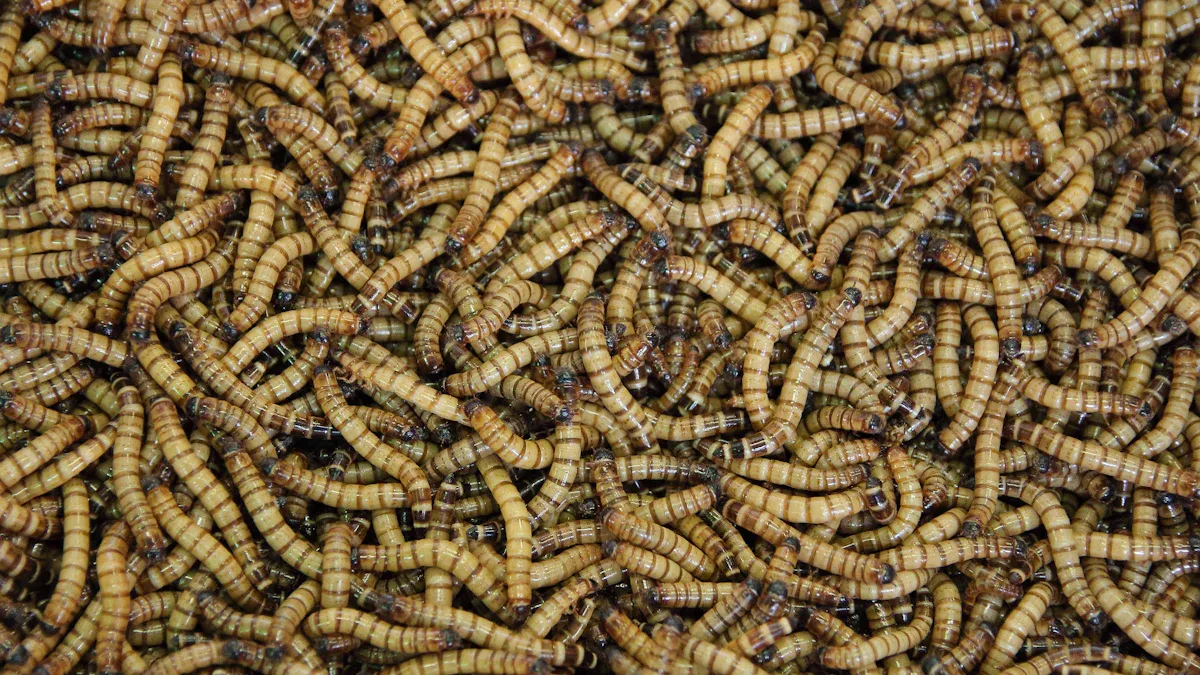
Dried mealworms for wild birds are a fantastic treat. They’re packed with nutrients that birds need to thrive: protein for growth, B vitamins for energy, and minerals for overall health. Preparing them properly makes them even more appealing. You’ll love watching birds flock to your yard for this nutritious snack!
Key Takeaways
- Rehydrating dried mealworms makes them easier for birds to eat and digest. This simple step helps keep birds healthy and hydrated.
- Mixing dried mealworms with seeds or suet creates a balanced diet for birds. This variety attracts more species to your yard.
- Proper storage of dried mealworms is crucial. Keep them in a cool, dry place to maintain freshness and prevent spoilage.
Why Prepare Dried Mealworms for Wild Birds?
Benefits of Proper Preparation
You might wonder why preparing dried mealworms for wild birds is necessary. Proper preparation makes them more nutritious and appealing. Here’s why:
- They’re high in protein, which helps birds grow and repair their bodies.
- They’re packed with B vitamins that boost energy and metabolism.
- They contain essential minerals and amino acids for overall bird health.
When you prepare mealworms correctly, you can also mix them with seeds. This creates a balanced meal that offers variety and keeps birds coming back for more. Using a specialized feeder can prevent waste and ensure the birds get the most out of their treat.
Importance of Rehydration for Birds
Rehydrating dried mealworms is a simple step that makes a big difference. Birds find rehydrated mealworms easier to eat and digest. Soaking them in water softens their texture, making them more like live mealworms, which birds naturally prefer. This added moisture also provides hydration, especially during hot weather or nesting season when water sources might be limited.
Think of it this way: by rehydrating mealworms, you’re not just feeding the birds—you’re helping them stay healthy and hydrated.
How Preparation Attracts More Birds
If you want to see more bird species in your yard, preparing dried mealworms for wild birds is the way to go. Birds are more likely to visit when food is easy to eat and packed with nutrients. Experts have observed that live mealworms attract even more birds, especially during nesting season. While dried mealworms aren’t alive, rehydrating them mimics the texture of live ones, making them just as appealing.
By offering prepared mealworms, you’ll create a bird-friendly environment that keeps them coming back for more.
Step-by-Step Guide to Preparing Dried Mealworms

Rehydrating Mealworms
Rehydrating dried mealworms is an easy way to make them more appealing to birds. All you need is a bowl of lukewarm water. Soak the mealworms for about 20-30 minutes until they soften. This process mimics the texture of live mealworms, which birds naturally prefer. Rehydration also adds moisture, helping birds stay hydrated, especially during hot weather or nesting season.
If you’re in a hurry, you can use warm water to speed up the process. Just make sure the mealworms are soft before serving. Birds like bluebirds and robins will appreciate the effort, and you’ll likely see more species visiting your yard.
Tip: Avoid soaking too many mealworms at once. Only prepare what you plan to serve in a day to keep them fresh and safe for birds.
Mixing Mealworms with Other Bird Food
To create a balanced diet for your feathered visitors, mix dried mealworms with other bird food. This combination provides a variety of nutrients that birds need. Here are some great options to pair with mealworms:
- Sunflower hearts for healthy fats
- Suet cakes or balls for energy
- Fresh fruit for vitamins
- Black sunflower seeds for protein
- Peanuts for extra energy
Start with a simple mix, like one part mealworms to two parts seeds or suet. Adjust the ratio based on how the birds respond. Rehydrating the mealworms before mixing makes them even more palatable. This approach not only enhances the nutritional value but also keeps birds coming back for more.
Serving Mealworms to Birds
How you serve dried mealworms for wild birds can make a big difference. Use a rimmed dish or a platform feeder to keep the mealworms contained. Hanging feeders with tall sides and roofs work well too, as they prevent the mealworms from escaping.
For the best results, offer mealworms alongside a water source. Birds need water for hydration, and having it nearby makes your yard even more inviting. If you’re introducing mealworms for the first time, try soaking them in lukewarm water to grab the birds’ attention. Over time, you’ll notice which birds prefer mealworms and can adjust your feeding strategy accordingly.
Note: Avoid scattering mealworms on the ground. This can attract pests and make it harder for birds to find the food.
Tips for Storing and Handling Dried Mealworms
Keeping Mealworms Fresh
To keep dried mealworms fresh and safe for birds, you need to store them properly. Here are some tips to help:
- Temperature Control: Keep mealworms in a cool place, ideally between 40-50°F (4-10°C). This slows down their metabolism and keeps them dormant.
- Humidity Management: A dry environment is key. Too much moisture can lead to mold growth. If needed, place a paper towel in the container to absorb excess humidity.
- Ventilation: Use containers with small ventilation holes to allow airflow. This prevents condensation and keeps the mealworms dry.
- Stock Rotation: Always use older mealworms first and refresh the bedding every few weeks to maintain quality.
Tip: Check for signs of spoilage like an off smell, discoloration, or unusual texture. If you notice these, it’s time to toss them out.
Safe Handling Practices
Handling dried mealworms safely is important for both you and the birds. Always store them in airtight containers or sealed plastic bags to prevent contamination. Freezing surplus mealworms at temperatures below -15°C can extend their freshness. When handling, wash your hands thoroughly to avoid spreading germs.
Workers in mealworm production facilities follow strict hygiene practices to ensure safety. You can do the same by keeping your storage area clean and dry.
Best Storage Containers and Locations
Choosing the right container makes a big difference. Opt for glass or plastic containers with smooth walls to prevent mealworms from escaping. Transparent containers are ideal because they let you monitor the mealworms easily. Avoid cardboard or wooden containers since mealworms can chew through them.
Store the containers in a cool, dry place away from direct sunlight. A pantry or a shaded shelf works well. By following these steps, you’ll keep your mealworms fresh and ready to serve to your feathered visitors.
Preparing dried mealworms for wild birds is easy and rewarding. Rehydrating them makes digestion easier, while mixing them with seeds or suet creates a balanced meal. Offering mealworms alongside water helps birds stay hydrated. Plus, feeding birds introduces you to nature, supports biodiversity, and brings the joy of birdwatching right to your backyard.
FAQ
How often should you feed dried mealworms to wild birds?
You can feed dried mealworms to wild birds daily, but in moderation. A small handful is enough to supplement their diet without overfeeding.
Can all bird species eat dried mealworms?
Most birds enjoy dried mealworms, especially insect-eating species like bluebirds and robins. However, some seed-eating birds might not show interest.
Are dried mealworms safe for baby birds?
Yes, but rehydrate them first. Softened mealworms are easier for baby birds to digest and provide essential nutrients during their growth phase.


